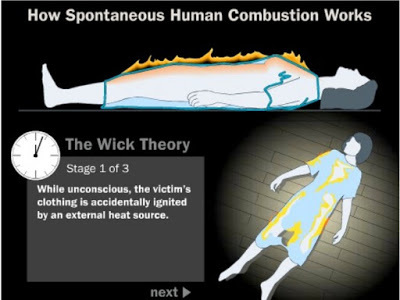C Is for Combustion
This month I'm participating in the A to Z Challenge. My theme this year is Unsolved Mysteries. Today's letter is:

In December of 2010, an Irish man was awoken by the sound of a smoke alarm in the house next door. When the fire brigade arrived, they found 76-year-old Michael Flaherty's body, partly burned, with no visible accelerant nearby.
 Michael Flaherty's homeAfter exhausting all possible other causes, the coroner ruled his death spontaneous combustion.
Michael Flaherty's homeAfter exhausting all possible other causes, the coroner ruled his death spontaneous combustion.

A similar case happened in 1957. Anna Martin was found in her bedroom, burned except for a small portion of her torso and her shoes. The medical examiner concluded that temperatures of at least 1,700 degrees would have been necessary to do that type of damage. Newspapers only two feet away weren't even scorched.

Spontaneous human combustion is a phenomenon that held more weight in previous centuries. Today's scientific minds refuse to believe someone could simply burst into flames. However, here are a few things that have historically been present with spontaneous combustion cases:
Victims are elderly or not very mobile.The fire damage is primarily confined to the victim.Feet and hands are sometimes unaffected by the fire.The damage to the body is far worse than it would be in a normal fire.
Of course, in a science-driven society, experts have worked hard to find an explanation for historical cases of spontaneous human combustion. They've come up with one moderately plausible explanation, called "the wick effect."

With the wick effect, it is believed that the clothing of an immobile human is ignited. When the fire comes into contact with the subcutaneous fat found in the human body, it combines with the clothing to act like the wick of a candle.

This creates the fuel necessary to catch the person on fire. However, in the case of Michael Flaherty, no ignition source was found. He died near a fireplace...but they couldn't find any evidence of a fire in it.

Do you think people can burst into flames without an external source?
⬅️ B Is for Brianna Maitland

In December of 2010, an Irish man was awoken by the sound of a smoke alarm in the house next door. When the fire brigade arrived, they found 76-year-old Michael Flaherty's body, partly burned, with no visible accelerant nearby.
 Michael Flaherty's homeAfter exhausting all possible other causes, the coroner ruled his death spontaneous combustion.
Michael Flaherty's homeAfter exhausting all possible other causes, the coroner ruled his death spontaneous combustion.
A similar case happened in 1957. Anna Martin was found in her bedroom, burned except for a small portion of her torso and her shoes. The medical examiner concluded that temperatures of at least 1,700 degrees would have been necessary to do that type of damage. Newspapers only two feet away weren't even scorched.

Spontaneous human combustion is a phenomenon that held more weight in previous centuries. Today's scientific minds refuse to believe someone could simply burst into flames. However, here are a few things that have historically been present with spontaneous combustion cases:
Victims are elderly or not very mobile.The fire damage is primarily confined to the victim.Feet and hands are sometimes unaffected by the fire.The damage to the body is far worse than it would be in a normal fire.
Of course, in a science-driven society, experts have worked hard to find an explanation for historical cases of spontaneous human combustion. They've come up with one moderately plausible explanation, called "the wick effect."

With the wick effect, it is believed that the clothing of an immobile human is ignited. When the fire comes into contact with the subcutaneous fat found in the human body, it combines with the clothing to act like the wick of a candle.

This creates the fuel necessary to catch the person on fire. However, in the case of Michael Flaherty, no ignition source was found. He died near a fireplace...but they couldn't find any evidence of a fire in it.

Do you think people can burst into flames without an external source?
⬅️ B Is for Brianna Maitland
Published on April 04, 2016 03:00
No comments have been added yet.



